INTRODUCTION
In August 1958 11 year old Lloyd first discovered the story of Pompeii in a very low budget horror movie. The following year I watched an Italian "Peplum (Sword and Sandal) movie starring American body builder Steve Reeves. I will mention both later, but that first film peaked my interest in archaeology. A subject very important to the story of Pompeii's destruction. When I was in the Navy during the Vietnam War I was stationed in Naples, Italy, and visited the actual ruins of Pompeii more than once. It is interesting from both a historical and archaeological point of view to see a very well preserved Roman city.
This article looks at the actual event, the novel and those feature films.
On October 16, 2018 my wife and I went to the "Ronald Reagan Presidential Library" in Simi Valley, California to see a touring exhibit with artifacts from Pompeii. The exhibit still dates the event to have taken place on August 24, 79 A.D.
However, according to the AFP International News Agency in Rome. On that same October 2018 date it was announced by Archaeologists working in Pompeii, which is always on going, the previous discovery of what is believed to be a date engraved on a wall from a construction worker in 79 A.D.. This discovery has moved the date of the eruption of Vesuvius to sometime after October 17, 79 A.D. The exact date is not known. The following link is to the British Website for "The Guardian" newspaper about this discovery.
https://www.theguardian.com/world/2018/oct/16/archeological-find-changes-date-of-pompeiis-destruction
This other link will take my reader to a video prepared for the "Ronald Reagan Library's" Pompeii exhibition about the destruction of the city. Pardon the quality as I filmed it. It was in 4-D and at one point smoke comes into the viewing area as my reader will see.
https://www.facebook.com/lafradkin/videos/10215174021456972/?t=5
A BRIEF HISTORY OF POMPEII
Pompeii was located in the Campania region of Italy. The city was 14 miles southeast of Neapolis (Naples) on at the southeast base of Vesuvius. While its wealthier sister city Herculeam was on the northwest side of Vesuvius. Oplontis was also buried by the eruption, but this was really a grouping of small villas and bath houses for the Roman upper class.
.

The following three photos are from the internet showing the three locations today.
POMPEII

HERCULANEUM

OPLONTIS
.
Pompeii is the most widely known of the three cities destroyed by Mount Vesuvius. This was initially from the novel "The Last Days of Pompeii" and when motion pictures started to be made/
The city was founded in either the late 7th, or early 6th Century B.C. by the Osci. They came to what would become Central Italy during the 2nd Century B.C. from East-Central Europe and spoke an extinct language called Oscan. The language was also spoken by another group in Southern Italy called the Saminites. Although they spoke the same language the two peoples were not related in any way.
Pompeii was used as a safe port by both Greek and Phoenician sailors. At some point the city was captured by the Etruscan's and in the ruins of the city archaeologists have found Etruscan writings and an necropolis built by that empire. Next the town was captured by the Greeks in the 5th Century B.C. by soldiers from the town of Cumae. Which was the first Greek colony on the Italian mainland. This didn't last long as during the late 5th Century the Southern Saminites conquered Central Italy. Pompeii was forced to construct any new architecture in the Saminite fashion. So now the city had four styles of architecture within its walls.
The Saminite War with Rome took place during the 4th Century B.C. and as a result Pompeii became a "socium (an associate of) Rome. However, the Roman's did not force their language on the city and it remained autonomous. The people fearing more warfare built walls around the three sides of Pompeii not facing the sea. Between 218 to 201 B.C. Rome became engaged in what was known either as "The Second Punic War", or "The War Against Hannibal". Pompeii felt allegiance to Rome and participated against Hannibal and his Carthaginians.
During the 2nd Century B.C. "The Temple of Apollo" was built and became the main center of religion in Pompeii. Allegiance to one group does not always stay together and in 89 B.C. Pompeii and the other towns of the Campania declared war on Rome. The group lost in 80 B.C. after a long siege by the Roman General Lucius Cornelius Sulla Felix known simply as Sulla.
Many of those who fought against Rome were removed from positions of authority, or killed out right. Pompeii was now a colony of the Roman Empire and an important sea port for goods arriving for Rome or Southern Italy.
It should be noted that a similar history existed for Herculaneum, but it was founded originally by the Saminites and not the Osci.
POMPEII A ROMAN STILL LIFE OF THE FIRST CENTURY A.D.
The following are a selection of my photos taken at the Pompeii exhibit at the "Ronald Reagan Presidential Library".
THE FIRST DESCRIPTION OF THE ERUPTION OF MOUNT VESUVIUS
The question always raised is why would anyone build a city next to a volcano in the first place? The answer is that Vesuvius had laid dormant for 800 years since any known activity.
The only historical document about the eruption of Vesuvius comes from two letters written by Gaius Plinius Caecillius Secondus known as "Pliny the Younger". Approximately 25 to 27 years after the event a friend named Gaius Cornelius Tacitus, a Roman historian, asked for a description of the death of "Pliny the Younger's" uncle known as "Pliny the Elder", but actually Gaius Plinius Secondus.
"Pliny the Elder" had been appointed praefectus class (fleet admiral) by Emperor Vespasian. On the date of the eruption he was stationed at the port city of Misenum (Miseno), see above map, and had a clear view of Vesuvius.
The fleet admiral was preparing to sail with some of his ships to get a closer look at the eruption, but prior received a message from his friend, Rectina, alleged to have been the wife of Senator Tascius Pomponianus Publius, to rescue them. The observation of the eruption now became a rescue mission. His cutter and other ships reached the shoreline between Herculaneum and Pompeii. When "Pliny the Elder" and his men went ashore they were able to locate the Senator, but not Rectina.
The group could not leave, because the winds the ships depended upon had changed direction. As they waited for the winds to once again change direction. The group found shelter while pumice was falling from the eruption and gases from the volcano were now starting to come their way. When the chance to leave finally came "Pliny the Elder" collapsed and was thought dead. He was left on the shore and the others escaped.
Three days later, after the volcanic plume had dispersed, the body of "Pliny the Elder" was found. According to the first letter written the date of his death was August 25, 79 A,D., but the second letter seems to indicate the eruption took place in November. That discrepancy in the date of "Pliny the Elder's" death has been debated by scholars until the discovery, this year, I mentioned above.
It should be noted that Pompeii was buried so deeply in ash and pumice. That overtime people had no idea were it was located as top soil was created. The city wasn't initially rediscovered, by accident, until 1599, or 1,520 years after Vesuvius erupted. Then once again forgotten. In 1738, Roque Joaquin de Alcubierre, a Spanish Military Engineer, while prospecting the proposed location of an Italian estate for the future King Charles III of Spain discovered the ruins of Herculaneum. He asked for and received funding to continue his excavations of the area and ten years later discovered Pompeii.
THE NOVEL "THE LAST DAYS OF POMPEII"
The following is the title page of the first volume of three that make up the novel by Edward Bulwer-Lytton.
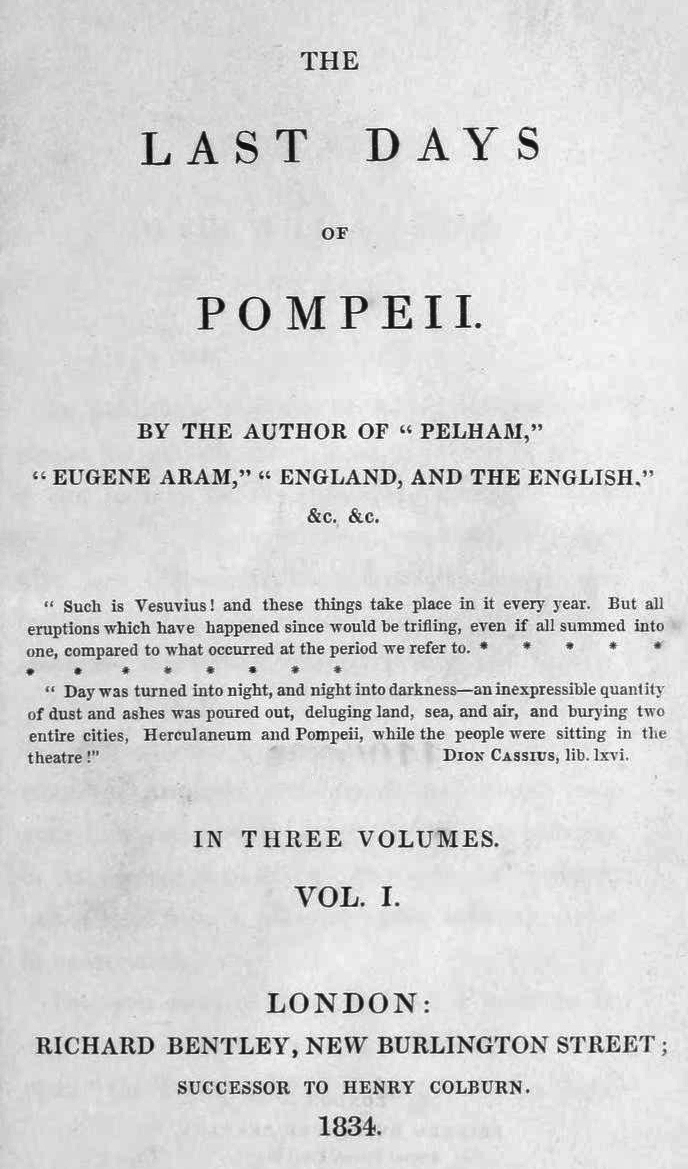
The novel was inspired by a large painting entitled "The Last Day of Pompeii". It was painted between 1830 to 1833 by Russian Karl Btyullov actually Charles Bruleau.

The following quote is by Annelisa Stephan, on the web page "The Iris", for the Getty Museum about the novel's characters and plot:
In brief, the novel follows two interlocking love triangles. At the center is the romance of two well-born Greeks, Glaucus and Ione, who must escape the grips of evil Egyptian priest Arbaces, who lusts after Ione. A delicious foe, Arbaces combines infinite wealth with magical powers and political acumen. The most complex, and therefore the most engaging, character is the Thessalian slave Nydia, a blind tweenage flower-seller. Alternately peevish and noble, childish and wise, she pines hopelessly for GlaucusAnother quotation:
Vesuvius casts its long shadow over every page of The Last Days. The Romans’ frettings about money, status, and dinner parties seem all the more decadent and perverse since their doom is nigh. We, civilized modern peoples, would never worry about such things! And Arbaces is so unkillable that only a lightning strike, which cinematically topples a massive column, can end him. I admit it: at times, I longed for the eruption. The blinding ash, hurtling rock, and choking vapors are a long-awaited Last Judgment that immolates the sinners and lifts the virtuous to paradise (read: Athens). Bulwer-Lytton makes you stop worrying and love the volcano.
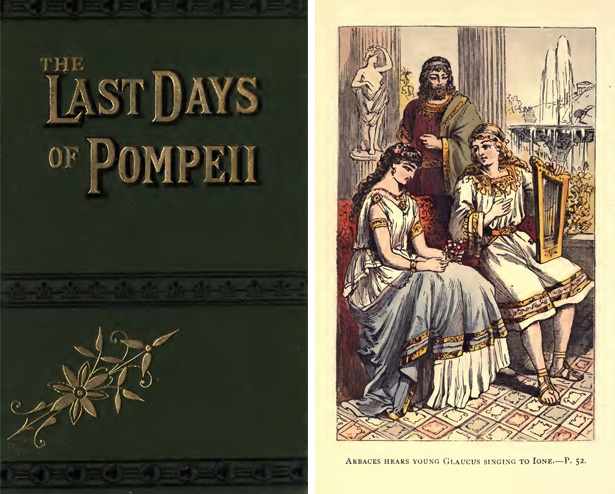
The article can be read at:
http://blogs.getty.edu/iris/apocalypse-then-bulwer-lyttons-the-last-days-of-pompeii/
THE MOTION PICTURES
For fun let me start with the film that brought my attention to the city of Pompeii.

The "Curse of the Faceless Man" was released August 13, 1958. As for the plot think the "Mummy" moved from Egypt to Italy, because the basic concept fits Universal Pictures 1940's "The Mummy's Hand" with "B" Cowboy star Tom Tyler as "Kharis", or Hammer Films 1959 "The Mummy" with Christopher Lee as "Kharis"/ Instead of a mummified Egyptian Priest the audience has a pumice encrusted Roman Gladiator named "Quintillus Auerlius".
Although most film critics compare the character to the 1932 Boris Karloff original in "The Mummy" from Universal Studios. Technically they're correct, but in the Karloff film "Im-ho-tep" is seen after a brief sequence in wrappings as a man with a parchment like face. Therefore, I believe the 1940 film that introduced "Kharis" is closer to this picture.
Pre-"The Six Million Dollar Man" and "The Bionic Women" actor Richard Anderson is "Dr. Paul Mallon". Elaine Edwards, whose career consisted of mainly television shows between 1952 and 1970, was, "Tina Enright", the reincarnated love of "Quintillus": from Pompeii.
At the dig in Pompeii a worker uncovers both "Quintillus" and a jewel box. Both are being sent to the Museum in Naples by truck, but the "Faceless Man" comes to life and kills the truck driver. The truck drivers body is inside the wrecked vehicle, but the gladiator is found several feet away and as there were no witnesses. The question of how he got out of the truck and ended up that far from the accident goes unanswered.

At the museum, which looks a lot like the Griffith Park Observatory in Los Angeles, "Dr. Carlo Fiorillo" asks "Dr. Mallon" to help him examine the body. He adds that he doesn't think "Quintillus" is actually dead, but "Dr. Mallon" considers that ridiculous. However, "Dr. Fiorillo" points to the dried fresh blood on the gladiators hands.

Meanwhile "Dr. Emmanuel" translates the Etruscan writings found on a brooch inside the jewel box. It tells of a curse being placed upon the gladiators owners by "Quintillus Aurelius". At "Tina's" studio she shows her boyfriend "Paul" a painting of a person from her dreams. It is "Quintillus" whom she has never seen.
"Paul" explains everything that happens and that night "Tina" goes to the museum to sketch the real "Quintillus". He comes to life and moves toward her as a Museum guard enters and shoots the gladiator. The "Faceless Man" kills the guard and "Tina" faints from fear. Tenderly the gladiator places the broach on her jacket. When help arrives they find "Quintillus" immobile once more and back on his display table.



Arriving at "Tina's" the scientists find "Quintillus" once more immobile at the feet of "Tina". "Dr. Fiorillo" uses an atomic age explanation for why the "Faceless Man" is alive. Apparently there was radiation inside the ash and pumice that fell on him and the museum using X-Rays on the body brought "Quintillus" back to life.
Back at the museum the scientists strap the gladiator down to keep him from moving about, if he returns to life again.
Later, "Dr. Emmanuel", using hypnoses regresses "Tina" to her previous Roman life. She says:
How can I return his love? I am an aristocrat. He is a slave and it is not permitted ...."Tina" suddenly stops in mid-sentence as she describes the eruption of Vesuvius. "Dr, Emmanuel" tells "Paul" that the Roman women was the daughter of the Senator that owned "Quintillus". To prove this assertion "Dr. Emmanuel" shows "Paul" a statue that is the image of "Tina".
As the continue their discussion the two scientists forget the young women is still in a trance. Unseen she cuts the bonds holding the gladiator down and he picks her up. Both the "Faceless Man" and "Tina" are now reliving the destruction of Pompeii. "Quintillus Aurelius" believes he is saving his loves life.

The "Faceless Man" heads for the ocean.


The police and the scientists arrive at the "Cove of the Fisherman" as the gladiator with "Tina" in his arms enters the ocean. To everyone's amazement the sea water causes his body to disintegrate and "Paul" swims out to save "Tina".
The movies based upon Edward Bulwer-Lytton's novel.
We know that the first film version of the novel was a 1900 silent short made in the U.K. and directed by Walter R. Booth. Apparently it shows Vesuvius erupting and some people in a room of a house escaping, but other than this information. There are no known stills, or film.
The next version came from Italy, released in December 1908, "Gli ultimi giorni di Pompeii (The Last Days of Pompeii)" was the first of four Italian productions. This film was Directed by Producer Arturo Ambrosio and Luigi Maggi. Director Maggi also starred as "Arbace" and the rest of the cast included Lydia De Roberti as "Nidia", Umberto Mozzato as "Glauco" and Ernesto Vaser as "ll padrone di Nidia",

The following link will take my reader to a video of the original 16 minute motion picture.
https://upload.wikimedia.org/wikipedia/commons/8/83/The_Last_Days_of_Pompeii_%281908%29.webm
In 1913 there were two productions of the novel from Italy. One is completely lost and no information appears to exist about that picture.
The surviving 1913 production of "Gli ultimi giorni di Pompeii" was Directed by Mario Caserini and Eleuterio Rodolfi and released first not in Italy but France in May 1913.
+1.jpg)
There are two versions of the film in release. The original running time was 88 minutes, but there is a shorter 56 minute version. The following link will take my reader to the full 88 minute version.
https://upload.wikimedia.org/wikipedia/commons/transcoded/0/04/Last_Days_of_Pompei_%281913%29.webm/Last_Days_of_Pompei_%281913%29.webm.360p.vp9.webm
The 1926 version of "Gli ultimi giorni di Pompeii" compared to all previous features was truly an epic. The picture ran 196 minutes and was in Stenciled Color by Pathechrome.
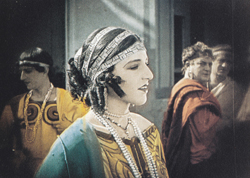
The cast consisted of Victor Varconi as "Glaco", Rina De Liguoro as "Lone", Maria Corda as "Nydia" and Bernard Goetzke as "Arbace". In fact the main cast consisted of 23 individual characters/ Something not normally seen outside of Hollywood.
On the web site IMDb is an excellent 2004 review of the production by dwingrove:
The last of the great silent Italian epics, The Last Days of Pompeii is as lavish as anything produced by Hollywood at that time - only much, much raunchier. During an orgy in the house of the evil priest Arbaces, naked slave girls are served up (literally!) on platters decked with flowers. A nubile mummy rises out of her sarcophagus to do a striptease and bare-breasted sphinx statues come to life as her chorus line. In the gladiators' tavern, wildly effeminate men (kohl-dark eyelids and lipstick as thick as clotted blood) drool and bat their eyes over so much naked, muscular flesh. All in all, the most satisfyingly decadent Ancient Rome saga until Fellini Satyricon in 1968!
In between the orgies and the rampant homoeroticism, directors Amleto Palermi and Carmine Gallone stick close to the Victorian melodramatics of Bulwer-Lytton's novel. The blind flower girl Nydia (Maria Korda) loves the dumb but good-hearted hunk Glaucus (Victor Varconi) who prefers the demure and aristocratic Ione (Rina de Liguoro). Ione, alas, is lusted after by the villainous Arbaces (Bernhard Goetzke) who also has a close...er...friendship with her brother Apicedes. A gorgeous young ephebe who resembles an Aubrey Beardsley angel, Apicedes can find nothing better to do than convert to Christianity. The best way, apparently, to 'wash himself clean of sin.'
You can always spot the Christians in these movies. They're the un-photogenic ones - the ones with glum faces and no jewels. But piety is no guarantee of salvation once Mount Vesuvius finally blows its top. The Grand Finale incorporates newsreel footage of an real volcanic eruption - so we're treated to the anachronistic but wholly delightful sight of two cameramen in modern dress, scurrying down the slopes to escape the burning lava! We watch, well-pleased, as the opulent sets crumble into still-more-opulent ruins. No, they really don't make 'em like that anymore! Not that anybody these days would have the nerve.On October 18, 1935 released by RKO Pictures was the first American production of "The Last Days of Pompeii". The feature was Produced and Directed by Merian C. Cooper with additional Direction by Ernest B. Schoedsack. For those of my readers unfamiliar with their names. These two friends and associates gave to Cinema::
KONG THE EIGHTH WONDER OF THE WORLDIn 1933 the team Produced and Directed both "King Kong" and "Son of Kong". My biography of Merian C. Cooper the real life "Carl Denham", spy for the "Office of Strategic Services (O.S.S.)" and creator of the 1950's movie process "Cinerama" can be read at:
http://www.bewaretheblog.com/2015/10/merian-c-cooper-before-king-kong-to.html
With their history it appeared Cooper and Schoedsack were the perfect duo to make the first sound version of Edward Bulwer-Lytton's novel. Additionally the two brought with them Stop Motion Animator Willis O'Brien and Model Maker Marcel Delgado.
Grand plans can fall apart from interference by the Studio. The plan was to make the picture in Technicolor/ The studio refused the funding. The plan was to have a gladiator fight on a thin walk way suspended over a pool with prehistoric size sail fish. RKO refused funding.

As to the cast of characters don't look for those found in the novel, but a title is worth box office recognition. This is Merian C. Cooper's "Biblical Epic" about a good man finding redemption and salvation through "Jesus".
Blacksmith "Marcus" portrayed by Preston Foster, Michael Curtiz's 1932 "Dr. X", 1943's "Guadalcanal Diary" and Sam Fuller's 1949 "I Shot Jesse James", sees his wife and son run over by a chariot. He seeks revenge and a new life. He becomes a gladiator and the most fierce of all.
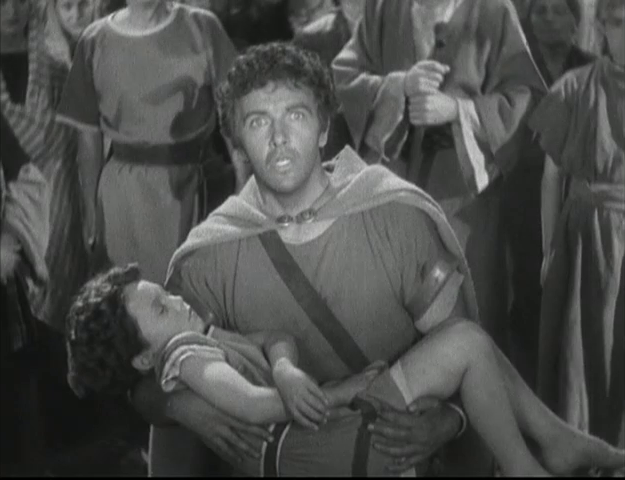
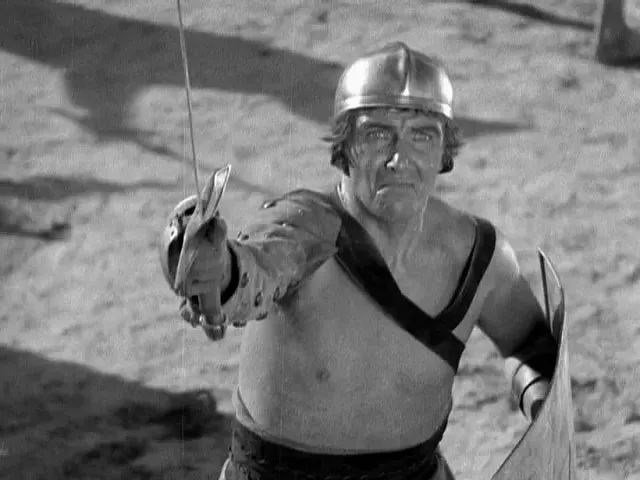
His change in attitude and direction comes after he kills an opponent only to learn he had a son. "Marcus" adopts the boy, "Flavius", and raises him as he would have his own son.
The film follows the two. The young "Flavius" has been thrown from his horse and is near death. "Marcus" asks is there anyone who can help him and a man, "Jesus", approaches and heals the boy. The film skips many years forward and "Flavius" is a young man in love with "Clodia" a slave he has rescued. What "Marcus" doesn't know is that his son is helping slaves escape.
Shortly after the young "Flavius" had fallen from his horse. "Marcus" seeking employment meets "Pontius Pilate", portrayed by Basil Rathbone, who employees him. In this screenplay "Pilate" sentences "Jesus" to death, but is shown as remorseful over what he was forced to do to an innocent man.
As "Marcus" and "Flavius" leave Jerusalem. One of the apostles recognizes him as the father who "Jesus" helped. He asks "Marcus" to rescue "Jesus" who is carrying his cross through the streets, but "Marcus" refuses. As "Flavius" and his father finally get out of the city. They notice three crosses with men a top a hill.
Father and son return to were this film began, Pompeii, and "Flavius" starts to help slaves escape. However, he is taken prisoner by Roman soldiers with a group he was leading to freedom."Marcus" visits his son in the cells beneath the arena.
"Flavius" and the others are herded into the arena to fight the gladiators. As the fighting begins Mount Vesuvius erupts.
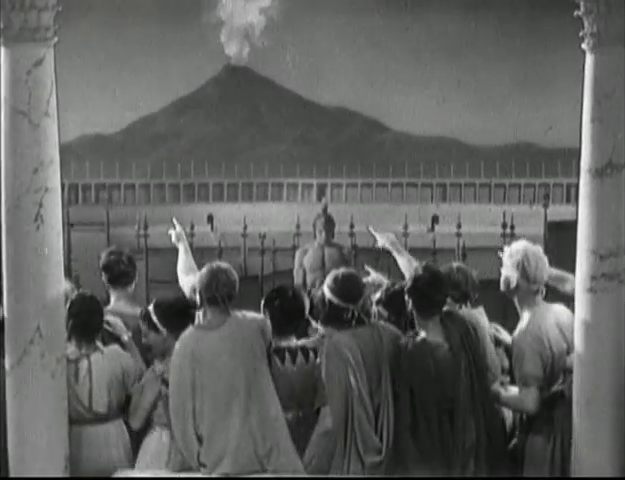
"Marcus" is cut off from his son and is walking through the streets of Pompeii in a daze as the eruption continues. He comes across a dying man. Who was the jailer that refused the request by "Marcus" to release "Flavius". The Jailer is dying and his son trapped in the rubble. He asks "Marcus" for mercy for his son and to help the young man get free. At first "Marucs" refuses, but remembers how "Jesus" helped his own son and changes his mind. Redemption and Salvation are at hand for the one time blacksmith.

At the water front there is a boat with slaves on it and "Marcus" realizes one is "Flavius". Even as Pompeii is being destroyed Roman soldiers are trying to stop the escape. "Marcus" holds the gate to the port shut to permit the boat to reach freedom. He dies saving his son and sees "Jesus" welcoming him,
The following link is to the destruction of Pompeii in the movie.
https://video.search.yahoo.com/search/video;_ylt=Awr9DWiZkMxbPUkAASVXNyoA;_ylu=X3oDMTByNWU4cGh1BGNvbG8DZ3ExBHBvcwMxBHZ0aWQDBHNlYwNzYw--?p=1935+last+days+of+pompeii&fr=mcafee#id=6&vid=c0ba8a7bd49c98c5172dc5d1726f6155&action=view
In an attempt to make money from his "The Last Days of Pompeii" and another financial failure "SHE" starring a young Randolph Scott. Marion C. Cooper paired the two films in a re-release package.

Released in Italy on March 2, 1950 and France on April 14, 1950 was an Italian and French co-production of "The Last Days of Pompeii" entitled in Italy "Gli ultimi giorni di Pompeii" and in France "Les Derniers Jours de Pompeii", but when the English language dub reached the United States in December 1955. The title was now "Sins of Pompeii".


There were name changes from the novel and in some cases depending upon it being the French, or Italian version. Those names were also even more different. For example "Claucus" became either "Lysia", or "Lysias", "Ione" became either "Elena", or "Helene". Yet, "Nydia" remained the same, but spelled "Nydia".
The plot was simplified and changed especially as it applied to the blind girl
The filming began in 1948, but for some reason the production was stopped for almost a year and then completed in 1949.
Released in Italy on November 12, 1959 and in the United States on July 17, 1960. When I saw STEVE REEVES in the Sword and Sandal version of "Gli ultimi giorni di Pompeii". In 1958 Joseph E. Levine had brought to the United States "Hercules", the following year "Hercules Unchained" and made Reeves an International Star.
American, and one-time Ed Wood actor, Steve Reeves was "Claucus" and German-Austrian actress Christine Kaufmann was "Ione". This was three years prior to her marriage to actor Tony Curtis. Spanish actor Fernando Rey was the High Priest "Arbaces". In 1971 Rey would become the "Drug Lord" in "The French Connection" and its sequel. American actress Barbara Carroll was "Nydia" and German actress Anne-Marie Baumann was "Julia".
The motion picture was Co-Directed and Co-Written by Sergio Leone.
Below Steve Reeves and Anne-Marie Baumann,
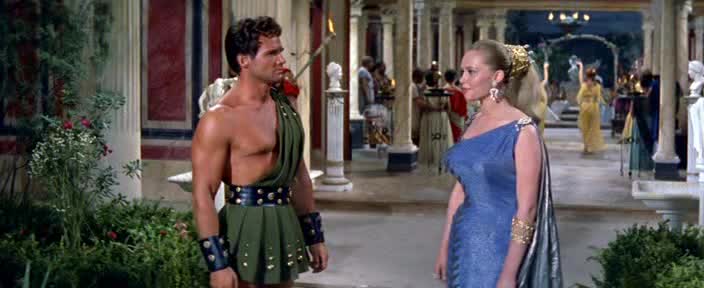
Below Barbara Carroll with Christine Kaufmann.

After serving in Palestine "Claucus" and his friends are returning to Pompeii when a run-a-way chariot with "Ione" is seen, :Claucus" saves the girl, the daughter of the town's "Consul" and starts again toward the town to see his own father. This same opening was used in "Hercules" except she was the King's daughter.
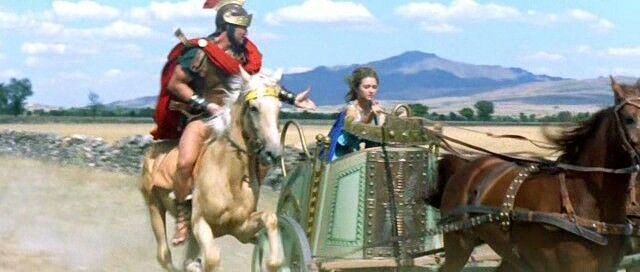
Still on his way he saves a young thief named "Antonius", Angel Aranda, who is being punished on orders of a Praetorian Guard named "Gallinus", Mimmo Palmara, When "Claucus" arrives at his father's house he finds it has been looted by a band of hooded thieves and his father murdered.
This is the set up for two love stories, "Claujcus" and "Ione" and "Antonius" and the blind "Nydia". The hooded thieves are actually led by "Gallinius" under orders from "Arbaces" to attack certain political enemies and secret Christians.
Below Angel Aranda and Steve Reeves.

This all leads to the arena with all four lovers charged by "Arbaces" as Christians and the eruption of Mount Vesuvius. The evil "Julia" and "Arbaces" will be crushed to death attempting to get the treasure stored in a temple during the eruption.
"Antonius" and "Nydia" die together in falling debris, but "Claucus" and "Ione" are saved.
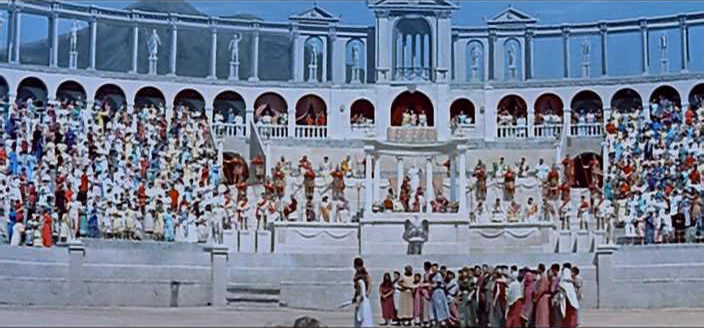
For those of my readers interested in both Steve Reeves and those Italian Sword and Sandal motion pictures. My article on the actor can be read at:
http://www.bewaretheblog.com/2015/01/steve-reevesa-look-at-his-films.html
In 1984 a Five Hour and Ten Minute mini-series of "The Last Days of Pompeii" was made at Pinewood Studios in London, England, but was an American-Italian co-production/

The screenplay was by Carmen Culver and is the closest adaptation to the original Edward George Bulwer-Lytton novel ever made to date.
The twelve main characters from the novel were portrayed by an International cast and were:
Ned Beatty as "Diomed", Brian Blessed as "Olinthus", Ernest Borgnine as "Marcus", Nicholas Clay as "Claucus", Lesley-Anne Downe as "Chloe", Olivia Hussey as "Ione", Slobhan McKenna as "Fortunata", Franco Nero as "Arbaces", Linda Purl as "Lydia", Anthony Quayle as "Quintius", Duncan Regehr as "Lydon" and Sir Lawrence Olivier as "Gaius". There were 30 speaking roles.
The picture was Directed by Peter R. Hunt. Hunt was the Film Editor for the James Bond films "Dr. No" and "Goldfinger" and Director of "On Her Majesty's Secret Service" among other works.


It would be another twenty-three years before Pompeii was seen again and this was a short lived Italian Soap Opera mini-series about the decadence of the people living there.There wasn't one name from the novel, or did the viewers ever get to the destruction by Mount Vesuvius.

The most current version as of this writing was in 2014 in a feature film called "Pompeii".
Released in the United States on February 21, 2014. "Pompeii" was inspired by the eruption of Mount Vesuvius, but not the novel "The Last Days of Pompeii". Its a United States, Canada and German co-production Directed by Paul W.S. Anderson who is known more for creating CGI historical video games.
The story is described on IMDb as:
A slave-turned-gladiator finds himself in a race against time to save his true love, who has been betrothed to a corrupt Roman Senator. As Mount Vesuvius erupts, he must fight to save his beloved as Pompeii crumbles around him.SPOILER ALERT: He finds her at the films climax and they die together. As does everyone else in this CGI production. One review called the movie a blood bath of love and gave it 2.5 out of 4 stars.
http://baltimorepostexaminer.com/pompeii-blood-bath-love-lots-death/2014/02/07
Below Kiefer Sutherland as the corrupt Roman "Senator Quintas Atticus Corvus".

The CGI work is impressive, but I wish the story was also.
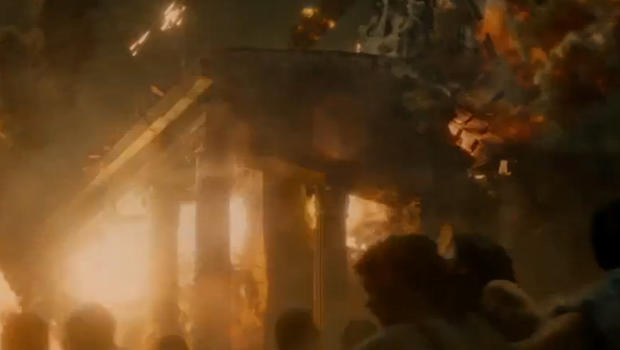

For 114 years film makers have re-imagined the destruction of Pompeii for audiences. Who knows when the next film will be made, but the true story of an entire city being buried in a volcanic cataclysm, lost and then found does keep peaking a viewers interest.
There is another volcano that caused World wide destruction when it blew up the island of Krakatoa. My article on the reality of the events felt around the world and the two adventure movies made may be read at:
http://www.bewaretheblog.com/2017/12/krakatoa-west-not-east-of-java-1883.html


























No comments:
Post a Comment